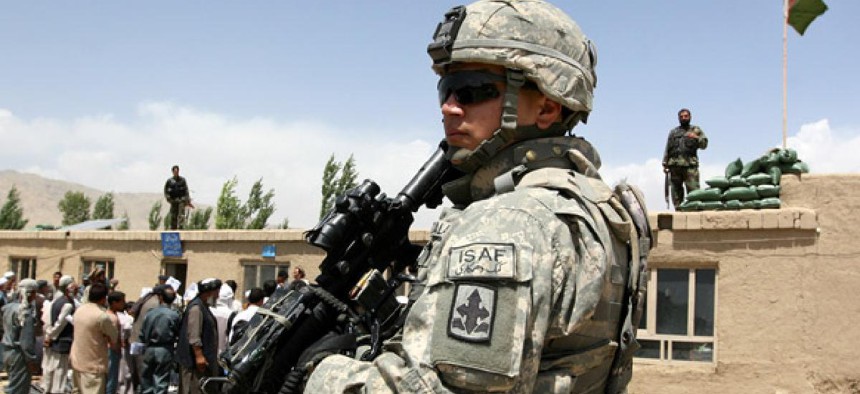
A U.S. soldier stands guard in Ghazni province, where more troops will be moved soon, according to reports. Musadeq Sadeq/AP file photo
Details emerge on coming U.S. offensive in eastern Afghanistan
5,000 U.S. troops to move east, with a focus on Kabul and the Pakistan border.
The last major U.S. offensive of the Afghan War is set to begin later this year in eastern Afghanistan, the region where the conflict began and where senior NATO officials hope their involvement will effectively come to an end.
U.S. officials in Kabul and Washington have provided National Journal an array of details about the coming push, which represents a high-stakes – and politically complicated - attempt to better secure Kabul as well as Afghanistan’s porous border with Pakistan before the American exit from the country accelerates. With Washington planning to shift U.S. troops out of their lead combat role next year, it is also likely to be the last major American offensive of the long war.
That foray will be led by thousands of troops from the 1st Brigade of the Army’s 82nd Airborne Division, set to deploy to eastern Afghanistan’s Ghazni Province in the coming months. The brigade will be augmented with additional combat, support and training personnel, which means the new U.S. influx could include roughly 5,000 additional troops.
A senior U.S. government official in Kabul, speaking on condition of anonymity, said the new troops will have three primary missions. First, they will work to expand the so-called “security bubble” surrounding the Afghan capital, which has been battered by a spate of insurgent attacks in recent months. Second, they will try to better connect Kabul with the key southern city of Kandahar, a hotbed of resistance NATO forces largely reclaimed last year.
The third mission will be the most important, the most complicated, and potentially the most dangerous. The troops, the senior government official said, will move towards the Afghan-Pakistani border as part of a broad push to reduce the numbers of anti-government fighters, weaponry and bomb-making material flowing in from Pakistan, where militants operate freely from large safe havens.
The new operations along the border will put the U.S. reinforcements against battle-hardened militants from the Haqqani network, which has emerged as the most skilled U.S. adversary in either country. Eastern Afghanistan’s mountains, unpaved roads, and rugged terrain will make it a difficult fight for both sides.
Navy Cmdr. Brook DeWalt, the spokesman for Gen. John Allen, the top U.S. commander in Afghanistan, said the overall goals of the campaign in eastern Afghanistan will be “for the forces to focus on an expanded Kabul security perimeter, the link between Kabul and Kandahar, and the border areas.”
The spokesman declined to discuss the exact timing or size of the new push, citing the need for operational security. Information on the coming deployment of the 82nd Airborne brigade, which hasn’t yet been disclosed by the Pentagon, came from the unit’s official Facebook page and a US. official with knowledge of the plans.
The new military push will unfold very differently from those which followed the Obama administration’s initial troop surge into Afghanistan, in part because all of those 33,000 are set to return to the U.S. by the end of this summer.
The surge troops were almost entirely deployed to the restive southern provinces of Helmand and Kandahar, long-standing Taliban safe havens which held special significance for the armed movement because many of its key leaders were born there. U.S. forces built a network and set up combat outposts throughout both provinces and manned them for more than a year.
Violence across the south has fallen since the push, but it’s far from clear that the largely unproven Afghan security forces will be able to hold – or expand – those modest gains when U.S. troops begin to depart the region to shift east or return home.
The new offensive into eastern Afghanistan won’t involve such a sustained effort. Instead, U.S. officials here and in Kabul say it will involve short assaults against specific targets. Troops may stay in a given area for a few days or weeks, but the current plans don’t call for them to set up large numbers of combat outposts or to remain in the region’s valleys or towns for months at a time.
American officials familiar with the coming offensive freely admit that its success is far from guaranteed. Defeating the Taliban or forcing them to come to the negotiating table will be virtually impossible so long as they can rearm inside Pakistan or use bases there to plan new strikes. But Pakistan has rolled back its modest counter-terror efforts because of widespread fury there over the unannounced U.S. raid into the heart of the country to kill Osama bin Laden and by a recent incident where an errant U.S. strike killed 24 Pakistani soldiers.
The U.S. has identified the specific Pakistani factories where most of the ammonium nitrate used in the bombs to kill and maim NATO troops is produced. Asked if Islamabad had taken any steps against the facilities, the senior U.S. official in Kabul didn’t hesitate. “As of this moment, they haven’t acted at all to shut down the factories on their side.”






